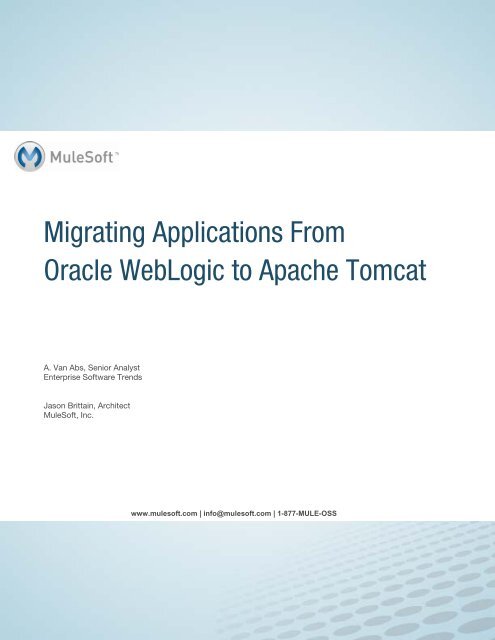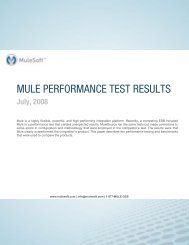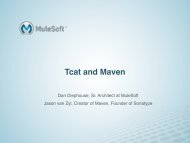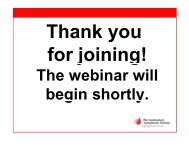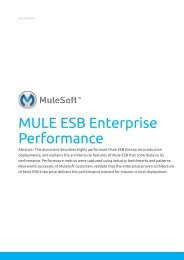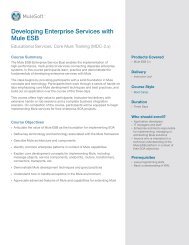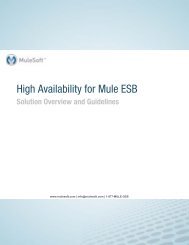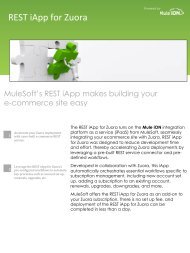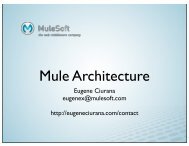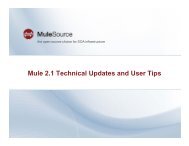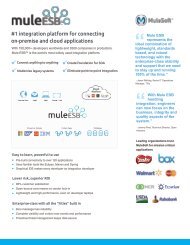Migrating Applications From Oracle WebLogic to Apache ... - MuleSoft
Migrating Applications From Oracle WebLogic to Apache ... - MuleSoft
Migrating Applications From Oracle WebLogic to Apache ... - MuleSoft
You also want an ePaper? Increase the reach of your titles
YUMPU automatically turns print PDFs into web optimized ePapers that Google loves.
<strong>Migrating</strong> <strong>Applications</strong> <strong>From</strong><br />
<strong>Oracle</strong> <strong>WebLogic</strong> <strong>to</strong> <strong>Apache</strong> Tomcat<br />
A. Van Abs, Senior Analyst<br />
Enterprise Software Trends<br />
Jason Brittain, Architect<br />
<strong>MuleSoft</strong>, Inc.<br />
MuleSource and the MuleSource logo are trademarks of MuleSource Inc. in the United States and/or other countries. All other<br />
product and company names and marks mentioned in this document are the property of their respective owners and are<br />
mentioned for identification purposes only.<br />
All contents Copyright www.mulesoft.com © 2008, MuleSource | info@mulesoft.com Inc.<br />
| 1-877-MULE-OSS
Contents<br />
1 Overview ............................................................................................................................................... 3<br />
2 Examining Migration Objectives: Why Migrate a Java EE Application .............................................. 3<br />
2.1 Reduce Complexity ...................................................................................................................... 4<br />
2.2 Reduce Operating Costs .............................................................................................................. 4<br />
3 Examining Java EE Application Migration Targets ............................................................................... 4<br />
4 Confirming Migration Ability ................................................................................................................. 5<br />
4.1 Techniques for Determining Migration Suitability ......................................................................... 5<br />
5 <strong>Migrating</strong> the Application <strong>to</strong> Tomcat .................................................................................................... 7<br />
5.1 Web Application Configuration and Code Migration .................................................................... 7<br />
5.2 Web Application Deployment ....................................................................................................... 7<br />
6 Conclusion ............................................................................................................................................ 8<br />
7 About the Authors ................................................................................................................................. 9<br />
<strong>Migrating</strong> <strong>Applications</strong> <strong>From</strong> <strong>Oracle</strong> <strong>WebLogic</strong> <strong>to</strong> Tomcat 2
1 Overview<br />
While it has been commonplace (and well documented) for IT organizations <strong>to</strong> migrate Java EE<br />
applications initially developed on <strong>Apache</strong> Tomcat upward <strong>to</strong> commercial Java application servers, such<br />
as <strong>Oracle</strong>’s <strong>WebLogic</strong>, in recent years the trend has been reversing. There are a number of compelling<br />
reasons for creating new web applications using <strong>to</strong>day’s deployment architectures on Tomcat instead of<br />
<strong>WebLogic</strong>, but perhaps even more interesting is the trend <strong>to</strong> migrate existing Java EE applications from<br />
<strong>WebLogic</strong> <strong>to</strong> Tomcat.<br />
In this white paper, we explore the reasons for migrating from <strong>WebLogic</strong> <strong>to</strong> Tomcat, considerations for<br />
making the decision, and techniques <strong>to</strong> be followed for a successful migration. Note that when we talk<br />
about Java EE applications, we are including applications, application components, and SOA service<br />
instances, each of which is an “application,” even when the user is another service or application, rather<br />
than a human.<br />
When we are discussing “migration,” we are focusing on those applications that would transition from<br />
<strong>WebLogic</strong> <strong>to</strong> Tomcat without major re-architecture or re-write. While it is theoretically possible <strong>to</strong> move<br />
any application from <strong>WebLogic</strong> <strong>to</strong> Tomcat, those involving sophisticated transactionality (EJB or<br />
CORBA, for example) would require so much development effort that they should be considered a<br />
completely new application, not a migration.<br />
While there is no single process for determining migration requirements and strategy, this white paper<br />
describes steps that can be used <strong>to</strong> make a migration decision and successfully implement it. The steps<br />
typically include:<br />
• Examine migration objectives: determine the reasons for the migration program. These may<br />
include business needs, cost savings, technical/architectural objectives, etc.<br />
• Examine migration targets: identify those Java EE applications with migration potential based on<br />
meeting the above objectives.<br />
• Confirm migration ability: assure that the selected Java EE applications can be migrated from<br />
<strong>WebLogic</strong> <strong>to</strong> Tomcat. This step will typically involve code analysis, trial migration, etc. Watch in<br />
particular for the use of “hidden services”... portions of <strong>WebLogic</strong> “au<strong>to</strong>-magically” used by your<br />
Java EE application without explicit developer activity. Also important would be considering any<br />
<strong>WebLogic</strong> or third-party administrative <strong>to</strong>ols used by IT staff, which might not be available for or<br />
compatible with Tomcat.<br />
• Identify external services: Determine those services external <strong>to</strong> Tomcat that may be needed,<br />
fac<strong>to</strong>ring in costs <strong>to</strong> provide those services.<br />
• Convert code: convert selected Java EE applications <strong>to</strong> Tomcat, coding as required and<br />
migrating administrative/deployment/management <strong>to</strong>oling as required.<br />
2 Examining Migration Objectives: Why Migrate a Java<br />
EE Application<br />
This is the first, and probably most important, question <strong>to</strong> ask, particularly when you already have a<br />
stable running Java EE application on <strong>WebLogic</strong> and there will be both costs and risks associated with<br />
making the changes. There may be a number of answers <strong>to</strong> this question, including the need <strong>to</strong> expand<br />
<strong>Migrating</strong> <strong>Applications</strong> <strong>From</strong> <strong>Oracle</strong> <strong>WebLogic</strong> <strong>to</strong> Tomcat 3
capacity, reduce IT systems complexity, retire <strong>WebLogic</strong> licenses due <strong>to</strong> vendor changes or <strong>to</strong> reduce<br />
overhead, and <strong>to</strong> reduece ongoing costs.<br />
2.1 Reduce Complexity<br />
Another frequent objective for migration is <strong>to</strong> reduce the complexity of the IT environments. While<br />
<strong>WebLogic</strong> is extremely powerful, it is also very complicated, both <strong>to</strong> program and <strong>to</strong> administer. Today’s<br />
IT budgets require “do more with less” processes and staffing, making it difficult <strong>to</strong> sustain such server<br />
environments.<br />
Developer productivity is also somewhat higher with Tomcat, particularly for those applications that do<br />
not require the complexity of <strong>WebLogic</strong>. Whereas a Java developer may take days <strong>to</strong> set up and<br />
configure instances of <strong>WebLogic</strong>, they can often do this in hours or even minutes for Tomcat. During<br />
development/debugging, Tomcat can be s<strong>to</strong>pped and re-started (“bounced”) in a few seconds, rather<br />
than the minutes required each time by <strong>WebLogic</strong>. In one study, this impacted developer productivity by<br />
more than an hour per day.<br />
Also driving complexity reduction is the need for IT agility. Whereas business applications used <strong>to</strong> take<br />
years <strong>to</strong> develop and deploy, business requirements now demand applications in weeks/months. This<br />
requirement drives architectural and process changes, including a transition <strong>to</strong> a more horizontal, lighterweight,<br />
more modular deployment architecture. <strong>WebLogic</strong> is both <strong>to</strong>o costly and <strong>to</strong>o heavyweight <strong>to</strong><br />
meet these requirements.<br />
2.2 Reduce Operating Costs<br />
Maintaining <strong>WebLogic</strong> is very costly, not the least because of the vendors service contract pricing, but<br />
also because of the amount of hardware required <strong>to</strong> support a <strong>WebLogic</strong> instance and the associated<br />
space/power/cooling costs. With typical Tomcat operating costs/server coming in at 1/4 <strong>to</strong> 1/6 the cost<br />
of <strong>WebLogic</strong>, many IT organizations are investing in transitioning all possible web applications from<br />
<strong>WebLogic</strong> <strong>to</strong> Tomcat, reserving their <strong>WebLogic</strong> servers for Java EE applications that require EJB or<br />
other major Java EE facilities that Tomcat does not offer.<br />
3 Examining Java EE Application Migration Targets<br />
Selecting suitable Java EE applications for migration is an important step. Typically, it depends on the<br />
objectives from above, some educated guesswork regarding what applications might be suitable for<br />
migration, and some thoughts about cost savings. With multiple interacting fac<strong>to</strong>rs in play, this is<br />
typically a somewhat iterative process. For example, migrating a specific application might achieve<br />
business objectives, but upon detailed analysis, it might prove <strong>to</strong> be <strong>to</strong>o highly integrated in<strong>to</strong> <strong>WebLogic</strong><br />
services that are not available in Tomcat and <strong>to</strong>o costly/complex <strong>to</strong> provide as a separate Java process<br />
or separate add-on Java component.<br />
There are three general types of applications for which Tomcat is highly suitable. These are:<br />
1. Any web application that has primarily been developed using Tomcat during development and is<br />
currently running on <strong>WebLogic</strong> in production.<br />
2. User interface (GUI), including sophisticated dynamic interfaces with features like user-specific<br />
content, forms validation, etc.<br />
3. Application components (including SOA services), particularly those requiring highly horizontal<br />
scaling and non-demanding business logic.<br />
<strong>Migrating</strong> <strong>Applications</strong> <strong>From</strong> <strong>Oracle</strong> <strong>WebLogic</strong> <strong>to</strong> Tomcat 4
One recent example of a GUI motivated migration was the JSP for an order entry form in a highly<br />
successful e-commerce site, where the <strong>WebLogic</strong> server clusters were being seriously bogged down<br />
with accepting and validating cus<strong>to</strong>mer-entered data. In this case, instead of doubling the number of<br />
<strong>WebLogic</strong> licenses, they split the Java EE application by removing the GUI JSP/servlets (the web<br />
application), adding a Web Services interface, and moving those functions <strong>to</strong> a Tomcat server farm. The<br />
<strong>WebLogic</strong> loading immediately fell by over 70%, and the cost of the Tomcat server farm, including load<br />
balancing and grid clustering, was less than 20% of what the additional <strong>WebLogic</strong> licenses would have<br />
cost. Furthermore, as the demand increases, adding additional Tomcat instances costs them under<br />
$2,000 each, instead of $35,000 <strong>to</strong> $40,000 for <strong>WebLogic</strong> server instances.<br />
Evolutionary changes in application architectures have made lightweight Java containers an increasingly<br />
viable environment for <strong>to</strong>day’s enterprise applications, particularly those using service oriented<br />
architectures based on Web Services standards. Increasingly, IT organizations are de-composing huge<br />
vertical legacy applications running on mega-servers in<strong>to</strong> collections of more horizontal application<br />
components (Web Services, etc.) running on lightweight, low-cost servers. They are also encapsulating<br />
legacy systems in Web Services <strong>to</strong> enable a ‘building block” approach <strong>to</strong> future dynamic IT<br />
requirements. In both cases, migrating portions of the application from the <strong>WebLogic</strong> server <strong>to</strong> Tomcat<br />
provides operational efficiencies and improves IT agility.<br />
Where architectural changes are the motivating driver, you must still take a close look at both the costs<br />
and the details of the migration process. In some cases, portions of the existing application code can be<br />
readily split off, but often new code has <strong>to</strong> be written <strong>to</strong> glue the results <strong>to</strong>gether. Targets of opportunity<br />
in a conversion would include portions of the code that have <strong>to</strong> horizontally scale but that do not require<br />
sophisticated services. User interface code is one typical area <strong>to</strong> focus on, plus application components<br />
doing large volumes of relatively simple things.<br />
4 Confirming Migration Ability<br />
The next step in assessing migration is <strong>to</strong> determine whether the functionality used by the application<br />
requires a <strong>WebLogic</strong> server or whether it can be supported by Tomcat, perhaps with a small number of<br />
add-on application services. Studies have shown that in most cases, only very small portions of the<br />
<strong>WebLogic</strong> functionality actually was used in any one Java EE application. While having everything you’d<br />
ever need at hand in every server instance was convenient, it was also complex and highly costly, both<br />
in acquisition cost and ongoing maintenance.<br />
In some cases, the Java EE application from <strong>WebLogic</strong> will use one or more services not present in the<br />
Tomcat server. These may include data access/persistence, messaging, e-mail, etc. In these cases, the<br />
selected application services must be installed and configured, and typically the Java EE application<br />
code would be changed <strong>to</strong> use those specific third-party services.<br />
4.1 Techniques for Determining Migration Suitability<br />
With the differences between <strong>WebLogic</strong> and Tomcat in mind and suitable Java EE applications targeted<br />
for migration, we can turn <strong>to</strong> the migration process itself. There are several steps involved in the<br />
migration, starting with determining that the selected applications do not require services that will be<br />
missing in the Tomcat environment.<br />
You may use the following checklist <strong>to</strong> decide if your application can move from <strong>WebLogic</strong> <strong>to</strong> Tomcat:<br />
<strong>Migrating</strong> <strong>Applications</strong> <strong>From</strong> <strong>Oracle</strong> <strong>WebLogic</strong> <strong>to</strong> Tomcat 5
Fac<strong>to</strong>r<br />
Migrate <strong>to</strong><br />
Tomcat<br />
Next Steps<br />
Application has been developed<br />
using Tomcat as runtime during<br />
development<br />
Yes<br />
Determine configuration and deployment<br />
changes<br />
Application primarily uses servlets<br />
and/or JSPs<br />
Yes<br />
Check if app leverages any <strong>WebLogic</strong>specific<br />
services and identify their<br />
equivalent replacements for Tomcat<br />
Application uses Spring Framework Yes Determine configuration and deployment<br />
changes<br />
Application is written <strong>to</strong> be strictly<br />
standards-compliant<br />
Yes<br />
Determine if other Java EE technologies<br />
are used and identify equivalent<br />
replacements for Tomcat<br />
Application is third-party software<br />
that is also available for Tomcat<br />
Yes<br />
Obtain the Tomcat version of the web<br />
application and deploy it on Tomcat<br />
Application uses EJB or other<br />
<strong>WebLogic</strong> server functionality not<br />
readily available for Tomcat<br />
No<br />
Need code refac<strong>to</strong>ring <strong>to</strong> remove the use<br />
of such functionality. This is a “new<br />
application,” not a migration.<br />
An easy way <strong>to</strong> do a trial migration is <strong>to</strong> move the selected web application, perhaps stubbing out those<br />
previously noted sections, <strong>to</strong> Tomcat. This effort is primarily a configuration and deployment exercise<br />
and will be described in more detail below. At this stage, it is fairly rare for the web application <strong>to</strong><br />
function fully, unless the original developers were meticulous in assuring portability. Typically, a short<br />
debugging session either will result in a basically running web application or will surface previously<br />
unknown reasons that the web application will not readily migrate.<br />
Once the web application is basically running, it is extremely useful <strong>to</strong> be able <strong>to</strong> use the same test<br />
suites and <strong>to</strong>oling used <strong>to</strong> maintain the original <strong>WebLogic</strong>-based application. Although these are thirdparty<br />
<strong>to</strong>ols, they are almost always Tomcat compatible and typically ship on Tomcat by default. Where<br />
<strong>WebLogic</strong> moni<strong>to</strong>ring and debugging <strong>to</strong>ols have been leveraged, there are no comparable capabilities<br />
included in Tomcat, so either third-party <strong>to</strong>oling or commercialized versions of Tomcat which include<br />
moni<strong>to</strong>ring/debugging/administration functions must be used. This is typically the most frustrating and<br />
time-consuming part of the migration process, because <strong>WebLogic</strong> offers a rich suite, and the open<br />
source Tomcat does not include these features.<br />
<strong>Migrating</strong> <strong>Applications</strong> <strong>From</strong> <strong>Oracle</strong> <strong>WebLogic</strong> <strong>to</strong> Tomcat 6
5 <strong>Migrating</strong> the Application <strong>to</strong> Tomcat<br />
At its most basic level, migrating a “clean” servlet/JSP application from <strong>WebLogic</strong> <strong>to</strong> an installed<br />
instance of Tomcat is a matter of bringing over the WAR file from <strong>WebLogic</strong>, setting up server.xml<br />
configuration parameters using your favorite text edi<strong>to</strong>r (including changing the hostname in server.xml,<br />
if you want <strong>to</strong> use anything other than the default localhost), deploying the application by placing the<br />
WAR file in<strong>to</strong> the appropriate hostname, and starting Tomcat.<br />
Once the software is installed, we have successfully moved clean example code from <strong>WebLogic</strong> <strong>to</strong><br />
Tomcat and had it running in a couple of hours. While this is possible in an IT environment, it is by no<br />
means the rule.<br />
5.1 Web Application Configuration and Code Migration<br />
There are well known differences in the web application configuration and file layout conventions<br />
between <strong>WebLogic</strong> and those of the Java Servlet Specification standard. If your web application only<br />
uses the documented standards, it should run on Tomcat, or it will be much easier <strong>to</strong> make it run on<br />
Tomcat. Making your web application more standards-compliant will also help you use more standard<br />
<strong>to</strong>ols such as Eclipse and its plugins <strong>to</strong> ease web application development going forward.<br />
Here are some of the items you should check and migrate <strong>to</strong> the Java Servlet standard:<br />
• If your web application has JSPs, make sure that any references <strong>to</strong> java.util.* packages have<br />
corresponding import statements in the JSP file.<br />
• Make sure the root of your web application direc<strong>to</strong>ry includes a WEB-INF direc<strong>to</strong>ry with a<br />
web.xml file inside it. The XML in this file needs <strong>to</strong> declare your mappings from any<br />
weblogic.properties file you had.<br />
• If you were already using a web.xml file for <strong>WebLogic</strong>, you will likely have <strong>to</strong> scrub it for<br />
nonstandard elements and attributes, and find the standard way of doing the same thing.<br />
Tomcat will point these out <strong>to</strong> you.<br />
• Move your classes direc<strong>to</strong>ry (if you have one) from the root of your web application <strong>to</strong> WEB-<br />
INF/classes.<br />
• Move any JSP files from your jspfiles direc<strong>to</strong>ry (if you have one) in<strong>to</strong> the root of your web<br />
application’s direc<strong>to</strong>ry. Tomcat requires them in the root of your web application.<br />
• Move any JAR files bundled by your web application <strong>to</strong> WEB-INF/lib.<br />
• Remove or stub out any code in your web application that imports/uses the com.bea.* or<br />
com.weblogic.* packages.<br />
Another container-specific idiom is for web applications <strong>to</strong> use the (now dated) “invoker” servlet, where<br />
the servlet isn’t mapped anywhere in the web.xml file, and the servlet is still invoked via a URI such as<br />
/servlets/com.mycompany.MyServlet. Tomcat comes with an invoker servlet that is turned off by<br />
default. If your web application uses the invoker, see the Tomcat documentation for instructions on how<br />
<strong>to</strong> enable it.<br />
Once you’ve made these changes, your web application will be significantly more standards-compliant<br />
and can run on standard web containers such as Tomcat.<br />
5.2 Web Application Deployment<br />
Deployment is a significant area of difference between <strong>WebLogic</strong> and Tomcat. In <strong>WebLogic</strong>, Java EE<br />
applications are deployed through the administration console, and the scope of application management<br />
<strong>Migrating</strong> <strong>Applications</strong> <strong>From</strong> <strong>Oracle</strong> <strong>WebLogic</strong> <strong>to</strong> Tomcat 7
is a <strong>WebLogic</strong> cluster. Application configuration is managed by the <strong>WebLogic</strong> Administrative Server<br />
(which can also be an application runtime server) and is maintained in an embedded proprietary<br />
database. A cluster can be widely distributed, and <strong>WebLogic</strong> au<strong>to</strong>matically distributes both the<br />
application and configuration across the cluster, verifying that each <strong>WebLogic</strong> server is up <strong>to</strong> date.<br />
Note: Tomcat lacks even rudimentary administration, which means you must manually edit<br />
configuration files during installation. Commercialized versions of Tomcat add<br />
administration/management/moni<strong>to</strong>ring capabilities <strong>to</strong> the basic Tomcat distribution, which adds<br />
significant value <strong>to</strong> Tomcat.<br />
Tomcat offers three options for deploying a web application:<br />
• WAR file: Manually moved in<strong>to</strong> the local machine, manual or au<strong>to</strong>matic local configuration<br />
• Unpacked web application direc<strong>to</strong>ry: Manually moved in<strong>to</strong> the local machine, manual or<br />
au<strong>to</strong>matic local configuration<br />
• TCP connection <strong>to</strong> remote manager webapp: Move either the WAR or the unpacked direc<strong>to</strong>ry <strong>to</strong><br />
the remote manager app.<br />
With s<strong>to</strong>ck Tomcat, you'll need <strong>to</strong> choose one of these deployment methodologies for each web<br />
application you want <strong>to</strong> deploy.<br />
6 Conclusion<br />
There are several steps <strong>to</strong> consider when migrating a Java EE application from one application server <strong>to</strong><br />
another, but migrating <strong>to</strong> Tomcat can bring your technology stack up <strong>to</strong> date while also offering<br />
significant licensing cost savings. At the same time, you can move <strong>to</strong> a popular open source application<br />
server that is well known and heavily used in the enterprise, and make your web application more<br />
standards-compliant <strong>to</strong> allow your developers <strong>to</strong> use their choice of industry standard developer <strong>to</strong>ols.<br />
<strong>Migrating</strong> <strong>to</strong> Tomcat from <strong>WebLogic</strong> will help your bot<strong>to</strong>m line, improve developer productivity, enable<br />
your operations staff <strong>to</strong> keep your web applications performing well, and allow for easier incremental<br />
application server upgrades. End <strong>to</strong> end, your server-side environment will be significantly more agile<br />
and cost-effective.<br />
<strong>Migrating</strong> <strong>Applications</strong> <strong>From</strong> <strong>Oracle</strong> <strong>WebLogic</strong> <strong>to</strong> Tomcat 8
7 About the Authors<br />
Andrew J. Van Abs<br />
Andrew is a founder of Enterprise Software Trends, a software consulting group in the Bos<strong>to</strong>n area<br />
focusing assisting clients with the evolving enterprise software landscape. He has created enterprise<br />
software architectures and strategies for more than 30 years and has also been responsible for<br />
developing a number of well known software products, including Netegrity’s SiteMinder, MEI Software’s<br />
Association Plus, and BEA Systems’ Enterprise Security product family. He was also Direc<strong>to</strong>r of Product<br />
Management for BEA Systems “Blended Source” program, an innovative blending of the best of<br />
OpenSource and commercial software.<br />
Jason Brittain<br />
Jason is a co-author of Tomcat: The Definitive Guide, now in its second edition.<br />
Before joining the team at <strong>MuleSoft</strong>, Jason was Senior Architect at Spigit, Inc. where he led a team of<br />
software engineers writing an idea management and prediction markets social networking web<br />
application for the enterprise. Before joining Spigit, Jason was a Senior Principal Software Engineer for<br />
Orbital Sciences Corporation, working at NASA's Ames Research Center on the Kepler Space Telescope<br />
mission (http://kepler.nasa.gov).<br />
Jason's specialties include the <strong>Apache</strong> Tomcat servlet container, Java software development, building<br />
social networking web applications, Tomcat web application development and deployment, scalability<br />
and fault <strong>to</strong>lerance, and Linux system administration. He has contributed <strong>to</strong> several <strong>Apache</strong> Java<br />
projects, and has been an active open source software developer for many years.<br />
About <strong>MuleSoft</strong><br />
<strong>MuleSoft</strong> provides enterprise-class software, support and services for the world's most popular open source<br />
application infrastructure products, Mule ESB and <strong>Apache</strong> Tomcat. With the lightweight and powerful Mule ESB<br />
and <strong>MuleSoft</strong> Tcat Server, <strong>MuleSoft</strong> is bringing simple yet powerful infrastructure <strong>to</strong> <strong>to</strong>day's dynamic Web<br />
applications. Today, <strong>MuleSoft</strong> products boast more than 1.5 million downloads and over 2,000 production<br />
deployments by leading organizations such as Walmart.com, Nestlé, Honeywell and DHL, as well as 5 of the<br />
world’s <strong>to</strong>p 10 banks. <strong>MuleSoft</strong> is headquartered in San Francisco with offices worldwide..<br />
For more information: www.mulesoft.com, or email info@mulesoft.com.<br />
Download Tcat Server: http://www.mulesoft.com/download/<br />
<strong>MuleSoft</strong> and the <strong>MuleSoft</strong> logo are trademarks of <strong>MuleSoft</strong> Inc. in the United States and/or other countries. All other product and company names and marks mentioned<br />
in this document are the property of their respective owners and are mentioned for identification purposes only.<br />
All contents Copyright © 2009, <strong>MuleSoft</strong> Inc.<br />
<strong>Migrating</strong> <strong>Applications</strong> <strong>From</strong> <strong>Oracle</strong> <strong>WebLogic</strong> <strong>to</strong> Tomcat 9


